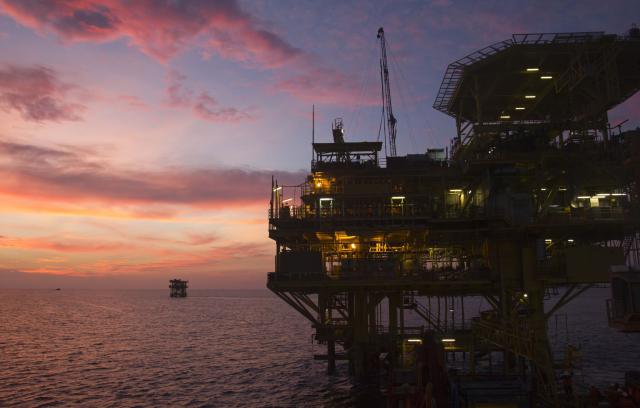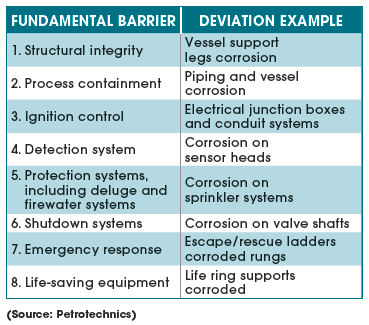
Emerging technology platforms can provide a new view of operational risk. (Source: Petrotechnics)
Corrosion is defined as “the degradation of materials reaction with its environment,” according to the National Association of Corrosion Engineers. Corrosion has been around since iron was first forged and its impact can be serious.
In Marsh’s “The 100 Largest Losses in the Hydrocarbon Industry 1974-2015,” it is very telling that “these largest losses did not result from so-called ‘black swan’ events but instead from the failure of prevention and mitigation measures to manage operational risks.”
A U.K. HSE paper stated that while the potential risks of vessel ruptures can be greater than leaks in pipework, 73% of corrosion failures occurred in pipework compared to less than 2% in vessels and tanks. Gaining access for inspection of lines to detect wall loss can be difficult, and not ensuring effective corrosion inspection and monitoring can have serious consequences.
A second study by Swiss Reinsurance Co. evaluated 45 incidents over the last 15 years in the oil, gas and petrochemical industry. In 52% of the incidents, mechanical integrity failure due to corrosion was cited as the primary cause, and 27% were a result of the failure of operating practices or procedures. Secondary causes were again integrity failure due to corrosion at 42% and poor design and/or inadequate hazard identification at 33%. While this does not address frequency, it evidences that the layers of protection or barriers to prevent major accident hazards are failing.
It is clear from these findings that better visibility of corrosion’s impact on asset integrity barriers would have been beneficial to all teams managing, maintaining and operating the facilities involved. They would have better understood whether the risk was increasing or diminishing on the asset, where they needed to dig deeper to understand the nature and drivers of the risk, and where they needed to intervene, prioritize and even escalate.
The challenge every organization faces is how to relate the performance of their asset integrity and process safety systems in a meaningful way to the operational reality of the plant. Too often process safety leading indicators end up being focused on individual program health and do not provide a forward-looking view of how all operational risks come together where it matters most—at frontline operations.
Process safety maintenance barriers
Barrier-based process safety models are quickly becoming the visualization tool of choice for the energy industry. They provide the opportunity to allow everyone from the boardroom to the frontline to see and manage all operational risks across the enterprise consistently. They can relate the collective performance of process safety systems to the real cumulative risk impact on operations at any given point in time.
The process safety barrier model advocated by the oil and gas producers association lists eight barriers, according to the International Association of Oil and Gas Producers’ Report 544.
Taking this model and applying it specifically to corrosion incidents, the accompanying table lists some deviations from performance standards, which would be found during routine mechanical integrity inspections. Such an inspection program is one of the risk control systems that must be in place to maintain the integrity of equipment and the health of the process safety maintenance (PSM) barriers.

Many operators have undertaken major accident hazard studies to help define the safety and environmentally critical elements (SECE) and identify the associated critical equipment on their facilities. Performance standards associated with each SECE also are defined, which allows operators to design their risk control systems to provide assurance that equipment performance is met through adequate inspection, testing and maintenance.
Tough times
Pressure is mounting for plant operators to improve productivity, manage costs and reduce risk simultaneously. The pressure to cut costs can result in increased repair and maintenance backlogs, unplanned shutdown frequency rising and declining production efficiency. What is required is the ability to give corrosion-related risks clear visibility on a process safety barrier model, allowing everyone to see and manage all operational risks across the enterprise consistently.
Providing risk visibility
Who knows what corrosion items are hidden in the inspection/ asset integrity department database? Yes, reports and risk assessments are available, and hopefully, mitigation measures are in place to manage operational risks from corrosion. However, what is the best practice for operators to make risk mitigation arising from PSM systems an integral part of efficient and effective operations?
If operators map the cumulative effect of deviations arising from all risk control systems, including those in place to monitor and manage corrosion, they will be able to see how the deviations are coming together to form major accident hazard pathways through the barriers. This provides the opportunity to proactively identify and prioritize corrective action from a major accident hazard management viewpoint.
Therefore, PSM can become an operational driver rather than just a compliance obligation. Understanding and managing the specific and cumulative risk impact of the deviations or nonconformances due to corrosion with the performance standards of a PSM system in the context of daily operations is the key.

Damage mechanisms
If a company is going to monitor damage mechanisms in real time as part of a robust process safety strategy, it should start by identifying what these are likely to be and what can occur while performing the initial process hazard analysis.
More than 80% of process hazard analyses performed do not comply with the current interpretations by the U.S. Occupational Safety and Health Administration, much less industry best practices. Most process hazard analyses address less than 10% of the hazards during startup, shutdown and online maintenance, and less than about 30% address damage mechanisms such as corrosion, erosion, external impacts, external stresses and vibration.
By connecting these damage mechanisms to a realtime barrier model, a company can better connect PSM to the operational reality of the asset.
Companies recognize the need to invest in asset integrity management systems, purchase of software, training of inspectors and filing systems to gather data on corrosion. Eventually, corrosion is observed and measured. The results of the survey entered in the asset management software are sent to the asset owner, the budget is applied for and work gets done before it reaches criticality. However, there is a missing link. How does the business know which issues are high risk and need immediate prioritization?
Emerging technology platforms can provide a new view of operational risk. There is technology that can give a facility risk and safety status in real time, alerting an operator when risk levels rise. Technology that assures asset integrity is sustained by a safety critical element monitoring in real time with repeatability. With better visibility of corrosion’s impact on the fundamental asset integrity barriers and the operational reality of the asset, everyone can make better-informed decisions that reduce risk, reduce costs and improve productivity.
References available. Contact Ariana Hurtado at ahurtado@hartenergy.com for more information.
Recommended Reading
SLB’s ChampionX Acquisition Key to Production Recovery Market
2024-04-19 - During a quarterly earnings call, SLB CEO Olivier Le Peuch highlighted the production recovery market as a key part of the company’s growth strategy.
PHX Minerals’ Borrowing Base Reaffirmed
2024-04-19 - PHX Minerals said the company’s credit facility was extended through Sept. 1, 2028.
BP Restructures, Reduces Executive Team to 10
2024-04-18 - BP said the organizational changes will reduce duplication and reporting line complexity.
Matador Resources Announces Quarterly Cash Dividend
2024-04-18 - Matador Resources’ dividend is payable on June 7 to shareholders of record by May 17.
EQT Declares Quarterly Dividend
2024-04-18 - EQT Corp.’s dividend is payable June 1 to shareholders of record by May 8.





